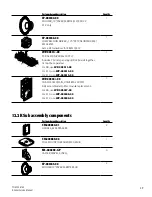
34
QSC Audio Products, LLC
9.3 Broken capacitor C45 (BOP)
PCB flex and vibration issues can also cause the leads on a large electrolytic capacitor, C45, to break. While the amplifier can
idle perfectly fine and play music at low power levels with the capacitor broken, the BOP will power cycle under high power
levels if a lead on the capacitor is broken because the capacitor can no longer provide sufficient charge to the supply . The
failure is extremely easy to find - simply remove the channel A gain knob - C45 can be checked from there.
Symptoms:
•
power cycling during high power levels only - runs normally
otherwise
Failure verification:
•
C45 has a broken lead (Figure 9.7)
Repair notes:
•
C45 can be quickly checked by simply removing the chan-
nel A gain knob. Push the capacitor back and forth with your
finger to verify the broken lead.
•
The symptom (power cycling) can be difficult to replicate.
•
The input board must be removed to replace the capacitor
with a new one.
9.4 Input op-amp damage (BOP)
If the customer accidentally applies a powered speaker-level signal to the input of the BOP, most likely the op-amp U14 will
fail. Because the op-amp is shared between channels A and B, either input can damage the op-amp. The QSC part number
for the MC33078 op-amp is IC-000048-30.
Symptoms:
•
Channel A or channel B green signal LED permanently lit without an input connected
•
BOP emitting noise or distortion to the output without an input connected
Failure verification:
•
Op-amp U14 has a DC voltage offset on pin1 or pin7
•
Audio signal does not flow through op-amp U14
Repair notes:
•
The op-amp is powered by a +15V and -15V voltage rail. If the op-amp has failed, there may be a short circuit across op-
amp U14 pins 4, 8, and ground. Check the impedance with the BOP powered off.
•
Check resistors R102 and R103 for open circuits. If the +/-15V voltage rails failed, these resistors will be open.
•
Apply a sine-wave source of 500mVrms @ 1kHz to input A or input B (not both) using an audio sine wave generator.
The gain pots should be set to 12 o’clock (0 dB). Check the measurements in the table below to find the location where
signal is lost or distorted.
Input Details
U14 pin1
U14 pin7
U17 pin1
U17 pin7 (to DSP)
Ch.A - 500mVrms @ 1kHz
0
240 mVrms
530 mVrms
757 mVrms
Ch.B - 500mVrms @ 1kHz
240 mVrms
0
530 mVrms
757 mVrms
•
The input section can be difficult to troubleshoot. If more than an hour is spent locating the problem, it may be better to
replace the PCB assembly with a new one.
•
The input/DSP board is not available as a spare part by itself. The power/amp board and input/DSP always come togeth-
er.
Figure 9.7 - Broken capacitor C45
Summary of Contents for K8
Page 2: ...2 QSC Audio Products LLC...
















































